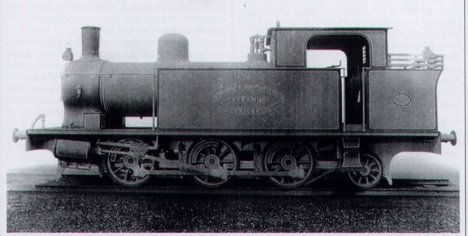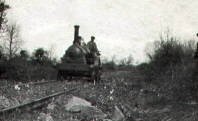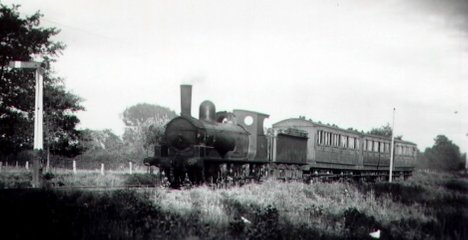Museum
Topics
Loco notes on the S&MR
Brian Janes has been re-examining some of the dates and events surrounding Rolling stock departures and arrivals
Shropshire and Montgomeryshire Light Railway locomotives, like those on several of the Colonel’s railways, are constantly listed or commented on but unfortunately inaccuracies are rife. A return to primary and contemporary sources is often more reliable, particularly Company minute books where they survive. The Colonel was not a great one for detailed minutes, confining them largely to matters financial, although some details of asset management did creep in. By Austin’s time this policy was abandoned and such details were discussed and minuted. This is an interesting reflection on Austen’s personality: autocratic with the workers, but slightly subservient with directors – something Stephens the patrician was quite incapable of.
The SMR minutes are therefore quite unrevealing about locomotive movements in Stephens day and such fascinating questions as the use and disposal after a short period of the two 0-6-2Ts (see below) cannot be found in the minutes. Primary sources elsewhere reveal that during the later stages of the long process of putting together finance to build the railway in spring 1909, Stephens had actively pursued the possibility of it being worked by the London and North Western and the Great Western Railway jointly. They declined to work it on a percentage of receipts basis and offered to do so on a train mileage basis but this proved unacceptable.
In May 1910 Stephens formally contracted to rebuild the line and furnish the stock and is reported in the Cambrian archives to have placed the order for the two new 0-6-2Ts by October 1910. For some reason these were delayed and the hotch potch collection was presumably hastily assembled by Stephens personally. The Company minutes note the purchase of one LSWR locomotive in February 1911(i). This became No 3 Hesperus, so Gazelle (No 1) and the 0-4-2ST Hecate (later Severn) (No 2) might be presumed to be already secured (but see below). The second Ilfracombe Goods was not referred to in the minutes until 30 May 1918 when it was reported that £550 was still owing to the Contractors (Stephens and Mathews, the company solicitor) for the locomotive no 5 Pyramus that had been delivered in November 1914. This engine had been purchased by the K&ESR from the LSWR under a five year hire purchase agreement. It would be interesting to know how Stephens handled the bookkeeping. The third Ilfracombe Goods, No 6 Thisbe was recorded in the minutes on 4 August 1916 as being subject to purchase from the LSWR over 2 years with a down payment of £286 (plus £15 for spares) and £200 and the end of the next two years. Bradley says that the Government discharged this debt in April 1917 but the minutes are silent on this point.
Gazelle
Ilfracombe goods on a S&M passenger train
Severn
Gazelle was clearly used for inspection at a very early date and is seen in several photos prior to the start of re-construction. At that stage it was still a 2-2-2WT and its long-term use as Criggion passenger engine, and probably reconstruction as a 0-4-2WT, was foreseen from the start. However when and where the work was carried out is a mystery. It may have been carried out in 1911 or 1912 but the first hard evidence is a report in the July 1913 Locomotive. This combined with its return with its new wheel arrangement in the 1913 statutory returns suggests that the changes, which probably included the passenger cabin and cab, were made in that year. As can be seen on the locomotive today this reconstruction was quite simple, if ingenious. As Allan Baker said in a letter to ‘Railway Bylines’ for April 2004 the reconstruction was highly unlikely to have been carried out by Bagnalls, as frequently reported, and there is no record of such work. The work was probably done at Kinnerley. The new driving wheels in particular are one piece castings from a pattern that was clearly made from the carrying wheels. Apart from the new connecting rods and new patch plates on the motion plate the only other changes were minor ones to brake hangers, springs etc. Thereafter she was employed on some of the Criggion passenger services till the late 1920s. A reconstructed working diagram for winter 1927/28 drawn by Stuart Pierce Higgins shows that it undertook one round trip Kinnerley to Criggion, each day.
Hecate’s early origins on the St Helens, LNW and the Bristol Port and Pier Railways and have been subject to accurate research by the RCTS. Its acquisition by the SMR was well documented in The Locomotive in 1922 probably with Stephens active involvement. That gives its arrival date as May 1911 (after opening) and it was reported in a noe by F E Fox Davies in that month that its arrival was delayed. It was certainly booked in for overhual at Bagnalls of Stafford in that month which would have been of uncertain duration. However both it and its number are mentioned in R E Davies’ article on the reopening in Transport and Travel Monthly for June 1911. It then spent its active life on mixed and quarry trains on the Criggion branch till set aside in the early 1920s. According to The Locomotive article the engine was renamed Severn during 1916.
The 0-6-2Ts were ordered before May 1910 but were certainty not at work before late summer 1911 and seem to have been regarded as SMR stock till at least 1915 as they are both reported in that years annual return. Thisbe was involved in a serious derailment in late July 1915 that was extensively reported and photographed. Sale to the Military railways probably took place in 1916. An advert for two locomotives of this description appeared in the Machinery Market Magazine for 11 February 1916. Further there is reference in a GWR report dated 9 June 1916 that two engines purchased by the War office from the S&MR were being overhauled at Wolverhampton Works. Although The Locomotive for November 1916 reports that their sale had been ‘lately made’ this was a report made under wartime conditions. They seem first to have worked on the Cannock Chase Military Railway but may have then moved to the Kinmell Camp railway that opened for traffic in November 1916. Thisbe moved on to the Longmoor railway in the same year. Another odd thing about these engines is that there is no trace of sale proceeds in the SMR's published accounts and their departure coincides with a final settlement (after many years) of the SMRs account with Stephens as the Contractor for rebuilding and equipping the line. Hawthorn, Leslie received £1725 worth of company debentures on 5th March 1912 presumably in part payment for these engines but what arrangements were made for the balance is not known. Stephens’ final payment was for less than the contracted cost and the adjustment could be in respect of these two engines. They might therefore even have been at least in part Stephens personal property when sold to the Military.
By the end of WW1 the railway seemed to have achieved stability in its locomotive policy with three Ilfracombe Goods and the Severn as the backbone of services. In the early 1920s however Stephens seems unable to resist the bargains on offer from the Military and swept three of his favourite engines, Stroudley Terriers, into the net. One came in 1921 and two in 1923. Their acquisition seems accurately documented by Bradley. Although some commentators seem to think they were little used there is no real evidence of this. Although they could clearly not handle heavy mixed trains or goods and were supplanted on the passenger services by the railcars they seem to have found a niche for a few years in the 1920s.
The real redundancy of this time was of the Manning Wardle No 4 Morous. Perkins excellent and informed article in the Railway Magazine for September 1911 on the reopening says it was used, together with another engine, as a contractors engine on the reconstruction. It was probably added to stock for duties unknown shortly after the opening. It was officially withdrawn following the arrival of the first Terrier in 1921, and was of no use whatever after the arrival of two more Terriers and the railcars in 1923. The Board seems to have forgotten its existence till in late 1931 when its sale to the West Sussex Railway was authorised following an offer to buy at £50. The Board wanted £60, even if it had to be in instalments, but eventually accepted £50. It is a wonder they remembered the engine as it had been on the West Sussex since at least 1924 possibly earlier.
With Stephens’ first stroke in 1929 Austen’s time as the SMR engineer came and bought changes both of locomotive policy and reporting. As early as 23 July 1930 he took command and he reported to the Board the proposed sale of ‘The Severn ‘ (No 2) to Wards for £47 and also No 5 (iii) for £134. These locomotives were noted as withdrawn in the 1930 accounts By October he had to report that the mainline companies would not allow the locos to be towed over their lines to the scrap yard so they stayed put. At this meeting it was also reported that that Terrier No 8 Dido had been reconditioned with No 7 Hecate’s boiler and that No 7’s remains were scrapped. Its wheels sent to Rolvenden in lieu of debt where they may still be extant under the K&ESR’s No3 Bodiam.
At the same Board it was reported that the railcar set had been damaged on 23 September and next month the Driver (probably Clifford Gill) was discharged as a result. This is probably when the unit lost its original pressed steel wheels and acquired 3-holed disc wheelsets.
The resultant need for steam engines forced the issue of engine availability and the acting Chairman was authorised in November to look for two second hand engines. This may have been in part retrospective authority as The Locomotive of 15 March 1930 had reported the purchase of the first Coal Engine from the LMS (No 8108) and therefore this had probably been available since that February.
Austen’s search for the second engine proved difficult. He had contacted the LMS and been offered two Webb Coal Engines for £420 and £390 but reported in January 1931 that they were in too poor a condition. By March he had inspected four more but only one (No 8182 at Sutton Oak) was any good. This incidentally shows how low LMS maintenance standards had sunk in the depression pre Stanier years. The loco had been bought for £380 (ii) and was in use by May
Although the railcars had been repaired by March they were now extravagant in Fuel (50 gallons a day) and more steam was running, requiring at least two daily steam duties with more on Summer Saturdays. In April 1932 the decision was taken to discontinue Railcar running from 30 April and dismiss the driver (S Nevitt) and rely on mixed trains. In fact the railcars were used thereafter on high days and holidays running about 2000 miles (i.e. perhaps on twenty days) annually till 1935 and perhaps on one or two days in 1936.Thereafter they were consigned to the sidings. Their demise probably prompted the resurrection of Gazelle and her trailer in 1937 to perform inspection and occasionally Criggion passenger specials.
The Locomotive for March 1932 contains an intriguing reference. Describing trials of an Armstrong Whitworth diesel railcar on the LNER and the subsequent refreshments it reports that in attendance were 'Mr Jas. Ramsey and Mr J Pike (Shropshire and Montgomeryshire Ry.)' Ramsay joined the SMR board on Rigby's death and was confirmed at the 1930 general meeting. He was described as MD (Acting) by May 1931 and became Chairman and Managing Director on Stephens' death in October remaining so until he himself died on 5th February 1943. John Pike OBE of Harrow Weald (who had retired etired as Goods Commercial Manager LMS in 1928) joined the Board at the same time as Ramsey and stayed a Director until he took over as Chairman on Ramsey's death.
Thisbe 1937
Kinnerley June 1932
Strange to see such distinguished representatives from a bankrupt railway viewing such a sophisticated railcar; or were they looking at one of the smaller AW jobs and joined in the jolly. Perhaps it was an early foray by newcomers into modernising the railway with diesels before economic reality struck home.
Back in May 1931 Austen was authorised to scrap three more engines and in July he reported that five engines would be scrapped, Nos. 2 and 5 (again), 6, 7 (already dismantled) and 8 (her reconditioning the previous year was thus of very limited use). The directors were no doubt impressed and double-reporting achievements are clearly nothing new. Austen was kept under pressure though and seems to have been required to report monthly. By November (when Stephens death was noted with great regret) he reported that 5 and 7 (again) were broken up and 2 and 8 in the process. In January he reported 5, 7 and 8 had gone, with 2 and No 5’s (iv) tender still remaining. No 2 was reported as still being broken up in October 1932. It was finally dismantled in May 1933. This seems to have settled directors minds but much of the scrap had not in fact gone as on 17 October 1933 the sale was reported of the Boilers of Nos. 2, 6 (iv), 7 and 8 to G R Jackson of Wednesbury for £100. The sale on 21 February 1937 of the partially dismantled remains of No 6 Thisbe (which had received No 3s boiler probably between July 1930 and November 1931) for £136/9/9 was reported. It was broken up on site in May.
With two Terriers withdrawn in 1931, the last, No 9 Daphne, was officially withdrawn in 1932 but lingered on intact in Kinnerley shed until bought in January 1939 by the Southern. Reported by Bradley as purchased for spares it does not seem to have been touched until scrapped in 1949. Daphne was an A1 in original condition and for some reason had been kept in a shed and well preserved by the SMR. Was it kept by Austen as a keepsake and intended for the Southern’s Eastleigh museum collection, only for that collection to be abandoned in 1940 when it was put out to grass? Boxhill later became the officially preserved Terrier.
The first two Coal Engines having proven their general utility one were successfully trialled on the Criggion branch on 28 June 1931 following considerable renewal of the permanent way in that year. The branches poor bridges stood the extra weight so the directors then decided to purchase a third (8236) but this did not arrive until 21 June 1932 for £375. This proved over optimistic. Unfortunately the government in those days of pre-Keynesian economics was cutting back on road building and by the end of that year the Criggion quarry traffic had collapsed. This was the end of the limited prosperity the line had enjoyed and it struggled on until Wartime when the line was to be transformed in the national interest.
(i) Bradley gives the dates of 12 January 1911 for No 3, May 1914 for No 5 (to the K&ESR), and 30 March 1916 for No 6.
(ii) Yeadon gives a sale date of March 1930 for 8108, March 1931 for 8182 and July 1932 for 8236. These were probably the official LMS withdrawal dates.
(iii) Bradley gives No 5s withdrawal date as October 1930.
(iv) No 6 had by this date acquired No5s old boiler and lasted another year or so
Sources
PRO records particularly RAIL 1057/1925, SMR Board Minutes RAIL 621
The Locomotives of the GWR Pt 3, RCTS, 1956
The Locomotives of the LB&SCR Pt 1, D L Bradley, RCTS, 1969
LSWR Locomotives, Early Engines and the Beattie Classes, D L Bradley, WSP, 1989
A Compendium of LNWR Locomotives Pt 2, Goods Tender Engines, W B Yeadon, Challenger, 1996.
Colonel Stephens Museum Archive






